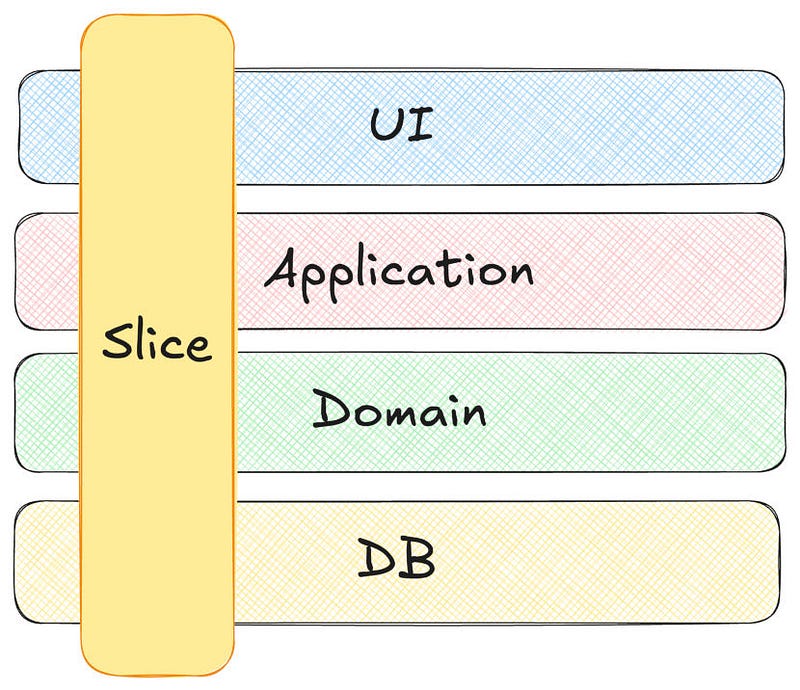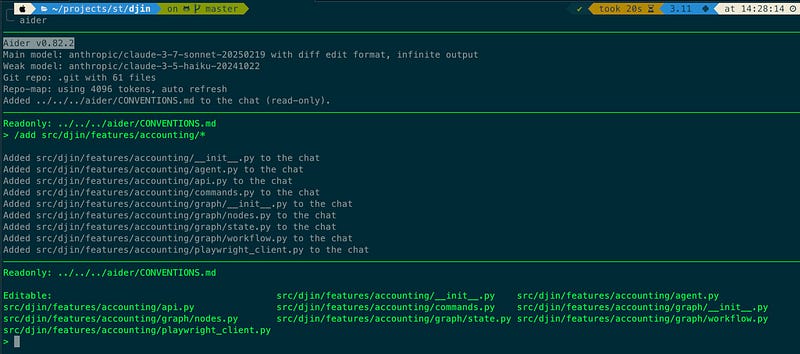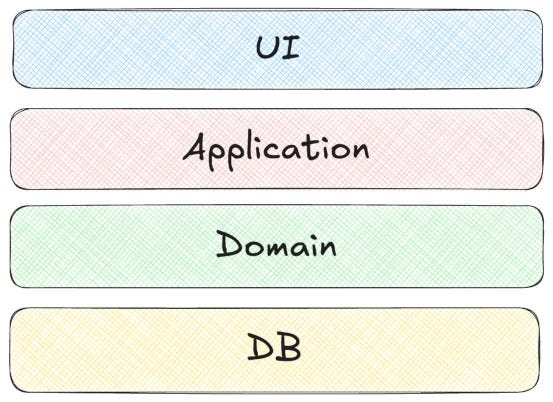AI‑Ready Software Architecture: Ship Faster by Design
Proven patterns that keep AI coding and you shipping

“These AI tools are useless,” Mike said, stirring his cappuccino. “We’ve tried everything you suggested. We tried Cursor, Copilot, Claude code, and managing that magic triangle technique you suggested. They generate garbage code that doesn’t fit our system.”
Mike, a former colleague, reached out after reading my article, “Good News, Devs: AI Boost Your Value.” He wanted to understand how I got the productivity gains I’d described.
As we talked, something emerged that I hadn’t emphasized enough before.
“Show me your codebase,” I said.
Mike’s expression moved from frustration to confusion. “What do you mean? It is pretty standard.”
“Let me guess,” I continued. “Layered architecture? Business logic separated from data access? Lots of dependencies? Documentation that exists primarily in your senior developers’ heads?”
He nodded slowly. “Yeah… how did you know?”
“Because your software architecture was designed for a different era”
I replied. “It’s like trying to run Netflix on a flip phone from 2005.
We’re experiencing a radical change in how software needs to be architected. Systems must now be AI-friendly, not just scalable, maintainable, and performant.
AI coding assistants' effectiveness directly depends on how well they can understand and navigate your codebase, and most existing architectures are essentially war zones for these AI helpers.
In this article, I’ll explore how the role of software architecture is changing with AI-assisted development.
I’ll also show why being AI-friendly isn’t just nice, it’s becoming essential for development speed and software success.
The AI architecture imperative
Should you tweak your software architecture for AI? Wrong question.
In 2025, AI‑symbiotic is a non‑negotiable quality attribute. You should rank it next to Reliability, Maintainability, Security, or any other ISO/IEC 25010 attribute.
The hidden integration tax
Study after study says the same thing: AI tools like Copilot increase raw code output but introduce a significant integration overhead, effectively acting like a 41% tax on layered stacks.
Context is the oxygen for machines
AI can’t mind‑read. You should start documenting the why, not just the what. If you use Architecture Decision Records (ADR), you should give the AI developer tool access.
Dmitriy Zhuk’s “Agent‑Friendly Code” proposes seeding every part of your code base with lightweight YAML front‑matter that tags scope, layer, and intent so LLMs can stitch context without crawling the whole repo.
It’s a modest scaffolding tax that pays for itself by turning GPT into an architecture‑aware teammate.
Dual audience design
Every artifact must speak to both humans and machines.
Timur Abduljalil’s AI‑First case study proves the point. After switching to Tailwind CSS and Shadcn, he dramatically reduced the number of interactions Claude needs.
Why? Tailwind provides a constrained vocabulary of classes (e.g., `flex-row`, `justify-between` for layout) that the AI can easily pick from rather than having to invent or understand arbitrary CSS.
Constrain the palette, expose intent, and your AI pair stops guessing.
- Code should tell a story, not just compile.
- Docs live beside the code, searchable and semantic.
- APIs are boringly predictable.
- Constraints are just tight enough to prevent chaos.
Theoretically, these principles are compelling, but how do they apply to real-world architectures?
Software architecture patterns through the AI lens
It is interesting to look at some of the most used software architecture patterns and see how they stack up against each other when using them with modern AI developer tools.
Vertical slice architecture
This architecture was first cited in a blog post by Jimmy Bogard in which he describes that you should organize your architecture and codebase by feature instead of by technical layers.

Each slice owns its API, business logic, and persistence. This architecture is one of the best regarding AI friendliness. This is because managing your context becomes very easy. You can let your AI tool load a single folder and let it see the complete slice.
See below where I load all the code of the accounting feature of Djin, my AI assistant, into the context of Aider.

- Best for: product‑led teams, agile development, rapid iteration.
- Watch out for: the temptation to create “common” helpers that leak across slices. Guardrails or bust.
Layered software architecture
Most developers have used or are using the layered software architecture. Buschman et al. describe this in “Pattern Oriented Software Architecture” as:
This pattern helps to structure applications that can be decomposed into groups of subtasks in which each group of subtasks is a particular level of abstraction.

The reason that you make it more difficult for AI tools and yourself is that when adding a feature you probable have to select and add multiple files of each layer to be available in your context. Also the technical layers in this have the tendency to become one big ball of spaghetti code.
- Best for: small apps, strict separation of concerns.
- Trade‑off: pays traditional orderliness, taxes AI efficiency.
Microservices architecture
A microservice architecture is an application design pattern where an application is built as a collection of small, independent, and loosely coupled services that communicate through APIs.

The concept of microservice architecture emerged from the evolution of service-oriented approaches in the early 2000s, with Dr. Peter Rodgers introducing the idea of ‘Micro-Web-Services’ in 2005.
Microservices architecture presents a unique case because although you split functionality into separate services that can interact with each other, the implementation of the service itself can still follow a vertically sliced or layered architecture.
So if you use a vertical sliced architecture for implementing your microservice your AI developer tool will be more happy.
Pipes and filters architecture
The pipes and filters architecture is a special pattern to build systems that process data streams. Below an example of a compiler from Buschman et all. for a non existing programming language called Mocha.

Buschman et al. describe the pattern in “Pattern Oriented Software architecture” as:
The pipes and filters architecture pattern provides a structure for systems that process a stream of data. Each processing step is encapsulated in a filter component. Data is passed through pipes between adjacent filters.
Each stage ingests, processes, hands off — ETL, MLOps, and compiler passes love this.
If you organize the source code of your application, which uses a pipes and filters architecture, so that all the code of a single filter is constrained within a single folder, you make it AI-friendly.
AI agents grasp the linear flow, optimise a step, and never touch the rest.
- Ideal for: data pipelines, build channels, and content transforms.
- Limit: rigid; feature work outside the pipe feels bolted on.
Choose the map that your AI can read
The AI friendliness of all these patterns revolve around one question. How many files must an AI open to change feature X?
Fewer files, tighter context, better suggestions. Pick the pattern that keeps that number low.
Understanding these patterns is essential, but adopting them requires a shift in how we, as architects, view our role.
The architect as director
A routine code review flipped my worldview. A junior dev breezed through a feature, guided by Copilot, and I realized my job wasn’t shrinking. Instead, it was leveling up.
Our roles are changing from being the primary builders to guiding the overall process, ensuring human and AI contributions integrate effectively and move the product forward.
This needs several critical adjustments:
1. Select precise guardrails and boundaries
Effective collaboration, especially with AI tools, requires clear rules of engagement. Instead of rigid, overly prescriptive constraints, we need well-defined guardrails that prevent major issues while allowing progress.
These include:
- Module Boundaries: Explicitly define which components can interact and how, preventing unexpected dependencies. A simple one-pager can often suffice.
- Naming Conventions: Consistent naming (e.g., verbs first for actions, nouns second for entities) makes code more predictable and easier for both humans and AI tools to parse.
- Defined Integration Points: Specify a small, stable set of APIs or entry points for interacting with modules or services.
- Automated Enforcement: Use CI checks and linters to automatically flag or prevent code that violates these selected boundaries and conventions.
A team I helped increased its throughput by applying practical guardrails. Their AI helpers became significantly more effective, generating code that fit the system rather than needing extensive rework.
2. Promote reusable patterns for consistency and scalability
While AI can generate code quickly, depending only on ad-hoc solutions leads to inconsistency and technical debt.
Promoting a curated set of architectural patterns is important. “Why patterns? AI writes the code now!” Because patterns provide a shared vocabulary for solving common problems, making the codebase more coherent.
Maintain a lightweight catalogue of essential patterns that include:
- Feature slice blueprint (how we structure features)
- Cross-cutting concern recipe (e.g., standard logging, authentication)
- API contract rules (how services communicate)
- Error-handling idioms (consistent ways to manage errors)
By documenting and encouraging these patterns, you provide reusable solutions that your AI partners can recognize and apply accurately, leading to more maintainable and understandable code.
3. Balance standardization with necessary flexibility
While standards and patterns are vital, excessive rigidity stifles innovation and prevents teams from adapting to new challenges.
Conversely, too much freedom leads to entropy and makes it hard for AI tools (and new team members) to understand the system. The goal is the productive middle ground.
Define this balance explicitly, perhaps in a short “Architectural North Star” document that:
- Outline core principles (e.g., “Context over configuration,” “Prefer vertical slices”).
- Document preferred patterns and why they were chosen.
- Designate “sandboxes” or specific areas where teams are encouraged to experiment.
- Set unambiguous guidelines for when and how deviating from standard patterns is acceptable (and how to document it).
This provides sufficient structure for AI tools to be effective while empowering human developers to innovate responsibly.
4. Make architectural context explicit and accessible
AI tools can’t infer the reasoning behind design choices or understand implicit rules. Their effectiveness hinges on the context you provide.
Therefore, architects must focus on making this context readily available through:
- Architecture Decision Records (ADRs): Document the why behind significant choices.
- Living Documentation: Keep documentation alongside the code accurate and up-to-date. Remove obsolete information.
- Canonical Code Samples: Provide clear examples demonstrating the “right way” to implement common tasks or use specific patterns (“how we do X”).
- Explicit Boundaries: Clearly demarcate module, service, or slice boundaries so AI tools understand the scope and limitations of components (e.g., using naming conventions, directory structures, or even lightweight metadata like YAML hints).
Teams that actively curate and expose this context find that AI tools make fewer incorrect assumptions and generate more relevant, useful code.
5. Guide the process for human-AI synergy
Ultimately, these steps shift the architect’s focus. We move from primarily writing code to designing and nurturing the system within which code is efficiently created by both humans and AI.
Our role evolves; we must ensure the architecture facilitates this collaboration, removing friction, and guiding the technical direction.
It’s less about hammering every nail and more about ensuring the blueprints are clear, the tools are effective, and the overall structure supports rapid, reliable development.
This shift doesn’t mean less technical depth; it requires a broader view, focusing on the patterns, context, and guardrails that enable the entire team, human and AI, to ship faster and more effectively.
Directors wanted
We entered this journey thinking architecture was lines, layers, and limit checks. We’re leaving, knowing it’s a stage direction.
Your role has shifted from carpenter with a hammer to conductor with a baton:
- From designer to director: You orchestrate context, guardrails, and patterns so humans and AIs hit their cues.
- From code to choreography: Vertical slices feed machines the exact script, and metadata, flows, and ADRs keep everyone on tempo.
- From genius‑lone‑wolf to curator of collective intelligence: Your real product is a codebase both species can read.
Where does that road lead?
In the future, development tools will become much smarter. Compilers might automatically prevent poorly integrated code (‘ugly seams’), while IDEs could deploy multiple AI agents working together (‘multi-agent pit crews’) to instantly help with tasks.
Knowledge graphs could clearly visualize the codebase and dependencies, showing the best path for new features like ‘airport runways’.
Consequently, the architect’s role shifts to overseeing a ‘mission-control console’. This console would feature dashboards displaying system context, alerts when architectural rules (‘guardrails’) are broken, and controls to manage or stop AI tools that produce incorrect results.
What should you do?
Audit one module this week. If an LLM can’t grok it in a single prompt, refactor until it can. Document the why, tag the slice, and push the pattern to your catalogue.
Keep doing that, and soon, you won’t just ship software, you’ll conduct an orchestra that plays at machine speed without losing the human melody.
The blueprint changed. The building still needs its master planner. Pick up the baton.




